A Matter of Time
The Mayan Calendar and apocalyptic anxiety today
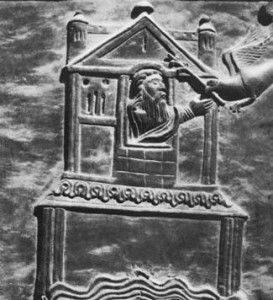 Fascination with apocalypse is at least as old as the story of Noah and still exerting its pull. The Mayan prediction of the end of all time, one year from now, the subject of the film 2012 and some 600 websites, is the latest to excite a frisson of fright. And yet, the planet’s looming problems—nuclear proliferation, the end of biodiversity, new plague-like viruses, the contamination of oceans, over population, and, most pressing of all, climate change—fail to arouse appropriate fear.
Fascination with apocalypse is at least as old as the story of Noah and still exerting its pull. The Mayan prediction of the end of all time, one year from now, the subject of the film 2012 and some 600 websites, is the latest to excite a frisson of fright. And yet, the planet’s looming problems—nuclear proliferation, the end of biodiversity, new plague-like viruses, the contamination of oceans, over population, and, most pressing of all, climate change—fail to arouse appropriate fear.
We Americans, at least, enjoy the fantasy of doomsday, while resisting the notion of its actual possibility. We don’t take seriously the idea of an end to human civilization as we know it, not sufficiently, in any case, to make sure it doesn’t happen. Many dismiss the scientific community’s urgent warnings of worsening conditions. But even those who credit the warnings find it hard to accept the predicted, dire outcome—or that it might be coming any time soon. We may worry; we may support green causes; but few of us actually lose sleep over our predicament. The Maya may not have the 2012 date right (and really, if they were so smart, where has their civilization been for the last thousand years?) but their calendar may still have a message for us.
In fact, if anything can be learned from the collapse of previous civilizations, Mexico may be the place with the most to teach. For over three thousand years, the region saw the rise of many distinct cultures each of which thrived for centuries and was then completely extinguished in a matter of decades. The sudden internal, generally ecological, collapse of a complex society—as opposed to a slow decline or fall to a more powerful nation—has occurred in various parts of the world throughout history, but nowhere else repeatedly. Jared Diamond’s best selling book, Collapse, details the Mayan end but skips over those that preceded it (the Olmec  ), were contemporaneous with it (Teotihuacan, the Zapotec, the Toltec), and followed it (the Mixtec). In fact, there seems to be no major pre-conquest Mexican civilization that
), were contemporaneous with it (Teotihuacan, the Zapotec, the Toltec), and followed it (the Mixtec). In fact, there seems to be no major pre-conquest Mexican civilization that
did not end in fire and brimstone: a precipitous decline in population and a violent destruction of cities. It began with the Olmec, who bequeathed all the other essential elements of ancient Mexican culture: an idiosyncratic pantheon, a corn-based agriculture, formal cities, human sacrifice, a ritual ball game, and a circular calendar. Except for the Aztec, whose apocalypse came by sea in the form of Cortes and his 530 ruthless adventurers, the many Mexican civilizations seemed to have shared a common fate.
Strangely, this pattern has not been addressed.  And yet why the pre-conquest Mexicans failed again and again to thwart collapse is a question worth considering, especially now, when we ourselves face such grave threats. As it happens, we and the ancient Mexicans are nearly as different from one another as it is possible to be—except, perhaps, in our response to serious peril.
And yet why the pre-conquest Mexicans failed again and again to thwart collapse is a question worth considering, especially now, when we ourselves face such grave threats. As it happens, we and the ancient Mexicans are nearly as different from one another as it is possible to be—except, perhaps, in our response to serious peril.
The many Mexican cataclysms present a curious puzzle but one worth tackling. The civilizations occupied diverse environments, from coastal marsh and seasonal desert to rain forest, making a common, purely ecological explanation unlikely. Their many ends occurred centuries apart, making climate change an unlikely common cause. Archeologists have posed various theories for each collapse: disease, deforestation, drought, corn blight, trade disruption, a destructive agricultural system, social upheaval, wasteful internecine struggles. Diamond convincingly posits a combination of such factors for the Maya.
But the specific cause for a particular collapse may not be the essential question. After all, most societies suffer extreme pressures from time to time and successfully overcome them. The question here is not so much how the collapses occurred, but why they continually repeated themselves. Logically, the answer must lie in some shared cultural feature, some essential, core belief. And given the ancient Mexican’s unique pattern of repeated collapse, that critical core belief should logically be unique to them.
Consider their concept of time—and their calendar of 2012 fame. 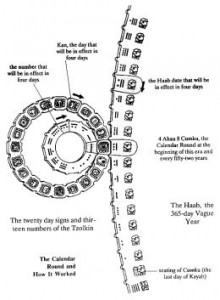 In pre-conquest Mexico, time was a consumable commodity, doled out by the gods in multiples of 52 years. Beginning with the Olmec, time was recorded with three permutating wheels—one of 13 symbolic numbers, one of 20 named days, one of 18 named months—which interlocked like clockworks, generating a different combination for each day in the 52 years, each with its own omens and required observances. At the completion of the cycle, the first day of each wheel again coincided. From written accounts we know that among the Aztec and Maya, but probably in the previous, less-literate civilizations as well, at a cycle’s end the continuity of the universe was seen to be in jeopardy. All fires were extinguished and, as darkness fell, priests made blood sacrifices and prayed through the night for the gods to allow the sun to rise again, granting another 52 years of life. If the approach of a millennial, even a centennial date can arouse anxiety in us (remember Y2K?), imagine the potential for anxiety in civilizations that did not believe in an automatic tomorrow. In Mesoamerica, time did not move forward; it revolved. Instead of progress, there was death and rebirth and death, again and again.
In pre-conquest Mexico, time was a consumable commodity, doled out by the gods in multiples of 52 years. Beginning with the Olmec, time was recorded with three permutating wheels—one of 13 symbolic numbers, one of 20 named days, one of 18 named months—which interlocked like clockworks, generating a different combination for each day in the 52 years, each with its own omens and required observances. At the completion of the cycle, the first day of each wheel again coincided. From written accounts we know that among the Aztec and Maya, but probably in the previous, less-literate civilizations as well, at a cycle’s end the continuity of the universe was seen to be in jeopardy. All fires were extinguished and, as darkness fell, priests made blood sacrifices and prayed through the night for the gods to allow the sun to rise again, granting another 52 years of life. If the approach of a millennial, even a centennial date can arouse anxiety in us (remember Y2K?), imagine the potential for anxiety in civilizations that did not believe in an automatic tomorrow. In Mesoamerica, time did not move forward; it revolved. Instead of progress, there was death and rebirth and death, again and again.
Periods of time longer than 52 years were recorded on another calendar, the Long Count, a permutation clockwork of bigger time wheels that generated a complete cycle of 13 baktuns, or approximately 5,200 years, with its starting point set at the mysterious date, August 13, 3114 B.C., in our calendar. In our linear system, time is recorded in an infinite progression forward and backward from the birth of Jesus. By simply changing the last numeral of the year each January 1, we generate a unique date for each day in history and reconcile the annual return of the seasons with the notion that time moves forward forever. But for the ancient Mexicans, the number of cyclic renewals was fixed and, among the Aztec and Maya at least, was limited to five epochs or Great Cycles, of which the present era was seen as the fifth and the last. Its end, and the final Armageddon of all time, is due to arrive on the last day of the 13th baktun, or December 21, 2012, when all the, by then, degenerate cultures of the world will be annihilated and the Great Cycle of the Long Count will be complete.
This ancient Mexican belief in finite time permeated their culture. Take Teotihuacan, the largest and most important of all pre-Cortesan cities, begun around the first millennium in Mexico’s Central Valley. Teotihuacan was a powerful megalopolis that thrived for 700 years (over twice as long as New York City is old). The city was laid out—as were other Mesoamerican cities—along directional lines of both religious and scientific significance. The Mexican belief system produced an urban architecture that, through its interaction with astronomical events, reaffirmed the belief system itself—a circular pattern that confirmed humanity’s inescapable place in a predetermined history.
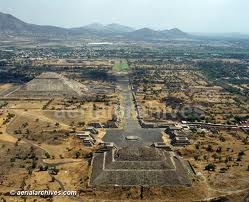 Even today, entering the site is a daunting experience. The archeological zone is limited to part of the central artery of the ceremonial core of the city, a section of roadway almost 150 feet wide and over a mile long—only half its original length. Bordering it on both sides are the crumbling remains of more than 75 temples, including two enormous pyramids. The boulevard is eerily familiar: it recalls the Mall of Washington, D.C. Even with what now are only the sketchiest of visual suggestions, it is apparent that this was a roadway designed to assert the power and glory of its city-state.
Even today, entering the site is a daunting experience. The archeological zone is limited to part of the central artery of the ceremonial core of the city, a section of roadway almost 150 feet wide and over a mile long—only half its original length. Bordering it on both sides are the crumbling remains of more than 75 temples, including two enormous pyramids. The boulevard is eerily familiar: it recalls the Mall of Washington, D.C. Even with what now are only the sketchiest of visual suggestions, it is apparent that this was a roadway designed to assert the power and glory of its city-state.
To walk up the boulevard is to participate in a carefully orchestrated, theatrical event. The paved roadway rises slowly almost 100 feet from south to just off north and culminates in the enormous Pyramid of the Moon, behind which looms the sacred peak of Cerro Gordo. Proceeding up the street, the viewer gets the impression that the pyramid is rising and the mountain peak descending until the two converge. Such a harmonious dialogue between a monumental city and its surrounding landscape must have made a powerful impression; it still does, even in its ruined state. 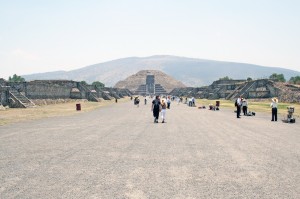 The overwhelming immensity of the site is draining. People at the other end of the road look as tiny as mites, and ten minutes of uphill walking gives little sense of progress. You quickly feel rather small yourself.
The overwhelming immensity of the site is draining. People at the other end of the road look as tiny as mites, and ten minutes of uphill walking gives little sense of progress. You quickly feel rather small yourself.
On any day, there may be several hundred other tourists in the roadway, probably considerably less than the normal amount of human traffic when Teotihuacan was the most populous city in Mesoamerica. It is estimated that at its height, from 500-700 A.D., it sheltered up to 200,000 inhabitants and covered over eight square miles, making it the sixth largest city in the world at the time. The city was laid out with over 2000 residential compounds on a grid of streets and alleyways that remained unchanged for hundreds of years. Rooms were grouped around open courtyards, rain was collected in cisterns, and underground drains carried off any excess. Interior walls were decorated with colorful, lively murals. The city attracted foreign workers who lived in separate neighborhoods and constructed their houses in the traditional styles of their homelands. This was a highly stratified, cosmopolitan city-state whose influence spread over much of Mesoamerica and whose trading routes extended over hundreds of miles.
 On the right, more than half way up the street is the city’s largest construction, a pyramid of such gargantuan size that it, in turn, dwarfs everything else. This is the Pyramid of the Sun and, for over 1500 years, from the beginnings of Teotihuacan until the arrival of the Spanish, the most sacred place in Mexico. It sits on top of the exact spot where, it was believed, the gods met to create the world and to set the cosmic clock in motion for the fifth and last time. In effect, the Sun Pyramid, fused the three dimensions of space with the fourth dimension of time.
On the right, more than half way up the street is the city’s largest construction, a pyramid of such gargantuan size that it, in turn, dwarfs everything else. This is the Pyramid of the Sun and, for over 1500 years, from the beginnings of Teotihuacan until the arrival of the Spanish, the most sacred place in Mexico. It sits on top of the exact spot where, it was believed, the gods met to create the world and to set the cosmic clock in motion for the fifth and last time. In effect, the Sun Pyramid, fused the three dimensions of space with the fourth dimension of time.
For the Teotihuacanos, nothing less than the responsibility for keeping the cosmos in motion resided there. The pyramid faces west where, according to their mythology, the sun plunges into darkness and begins its nightly and dangerous journey. In Mexican thinking, the universe was in constant jeopardy of grinding to a halt—an extraordinary notion. From Spanish accounts, we know that the Aztec, at least, believed that when the weakened sun reached the western horizon only the ritual spilling of blood guaranteed its rebirth the next dawn. Blood sacrifice was both a terrible, inexorable responsibility and a holy validation. It must have seemed to the ancient Mexicans that humanity’s fragile existence was at the mercy of vast, uncontrollable forces but, at the same time, that the entire universe depended on it, that the human being was at once powerless and essential.
Though Mesoamerican pyramids often contained secret passages and tombs, these were buildings that did not enclose space so much as they created enormous sloping public stages. A grand ceremonial stair, flanked on either side with ramps, leads up to the flat top where there would once have been a small wood and thatch temple. Here priests performed rites, including human and animal sacrifice, as the crowd watched from the plaza below. Today all visitors with enough energy climb the pyramid, but originally only participants in religious rites would have set foot on this sacred construction. However, since it towered over all the other buildings in the city, its public rituals could be seen from great distances. The sight of priests holding up their bloody offerings to the setting sun could not have failed to impress.
Keeping the cosmic clock in motion, insuring the observance of ritual days, and interpreting the calendar were among the principal functions of the priesthood. They studied the heavens and perfected their calendar, not just to record history but also to foretell the future. For them, as for all the ancient Mesoamericans, the more one knew about the movement of the stars, the more one could order one’s life in relation to what were considered auspicious or inauspicious celestial occurrences—though the basic framework of life was predetermined. Priests studied the night skies in order to predict the inevitable.
In basing the orientation and design of their city on precise astronomical findings, the elite fused scientific knowledge with religious belief, consolidating their power. The correct foretelling of lunar and astral events must have been a significant buttress to religious and state authority. Each year when the revered Pleiades star cluster first appeared when and where predicted, there would have been a powerful, reassuring sense of rightness. Teotihuacan knew where it stood: at the center of a universe that swirled around it. On the other hand, a city built to reflect the predictable turnings of the heavens must have felt locked into a mechanism over which it had no control.
Perhaps this sense of circular time and preoccupation with the prediction of repetitive astronomical events contributed—along with ancient Mexico’s isolation—to the cultures’ strange failure to progress technologically. Though the Indians worked gold for jewelry, they never invented metal tools or weapons. Though they knew the phases of Venus and could predict eclipses, they never learned navigation. It is true that their largest domesticated animal was the dog, but rather than use it as a draft animal, as did the Plains Indians and Eskimos, they used it for  food. They made wheeled toys for their children but never invented wheeled transport, continuing, until the arrival of the Spanish, to carry everything on their backs. Once established, the cultures of ancient Mexico seem to have stressed repetition of tradition over exploration of new ideas. Its cities were continuously under construction but structures tended to swell in size while remaining static in design, as new buildings simply engulfed older ones. Their intellectual elite was focused on unraveling the mysteries of the cosmos so as to perfect the present, not on problem solving to insure a better future.
food. They made wheeled toys for their children but never invented wheeled transport, continuing, until the arrival of the Spanish, to carry everything on their backs. Once established, the cultures of ancient Mexico seem to have stressed repetition of tradition over exploration of new ideas. Its cities were continuously under construction but structures tended to swell in size while remaining static in design, as new buildings simply engulfed older ones. Their intellectual elite was focused on unraveling the mysteries of the cosmos so as to perfect the present, not on problem solving to insure a better future.
Then, in 700 A.D. Teotihuacan collapsed. In 50 years, the population declined by 75%. Palaces and ceremonial buildings were burned and fell into ruin. The surviving inhabitants camped in remaining structures, depositing their refuse in courtyards, even in corners of rooms. The city deteriorated until it became unlivable, as in post-apocalyptic films, the demoralized survivors retreating to a more primitive state, picking through the ruins of the once great civilization.
 With a belief in circular time, such a collapse would have seemed a natural part of the cosmic order, since the past foretold the future for each succeeding civilization. Even when overgrown with vegetation, the formal geometry and projecting pyramids of Mexico’s fallen cities could never have been mistaken for a natural landscape. Instead they took on mythic significance, sometimes becoming sites for worship. The Aztec made regular religious pilgrimages to the ruins of Teotihuacan, as the Lacandones, the last unchristianized Mayan Indians, continue to worship today at ruins near Palenque. The silent remains of past civilizations must have powerfully confirmed apocalyptic expectations.
With a belief in circular time, such a collapse would have seemed a natural part of the cosmic order, since the past foretold the future for each succeeding civilization. Even when overgrown with vegetation, the formal geometry and projecting pyramids of Mexico’s fallen cities could never have been mistaken for a natural landscape. Instead they took on mythic significance, sometimes becoming sites for worship. The Aztec made regular religious pilgrimages to the ruins of Teotihuacan, as the Lacandones, the last unchristianized Mayan Indians, continue to worship today at ruins near Palenque. The silent remains of past civilizations must have powerfully confirmed apocalyptic expectations.
To what extent Teotihuacan’s end was foretold we are unlikely to know, but there is much evidence to show that the city had previously suffered many decades of intense internal pressure. In the last centuries before the collapse, though construction continued unabated, the population could not sustain itself and the city was forced to rely on an influx of outsiders. Studies of late burials in one of the poorer compounds have revealed evidence of terrible human suffering over several generations. As at Mayan and Mixtec sites, skeletal remains confirm increasing malnutrition: declines in stature, degenerative bone conditions, dental abnormalities, decreased average age at death, and infant and fetal mortality of extraordinary proportions.
 Why did the Teotihuacanos not resist the deteriorating conditions of their society? Nearby the great lake of the Central Valley lay shimmering, its tremendous agricultural potential untapped until the arrival of the Aztec 500 years later. The Teotihuacanos were already using on their own river shores the same “floating garden” technique on which the Aztec’s agricultural success would later be based. What kept them from just getting up and moving one-day’s walk to the south?
Why did the Teotihuacanos not resist the deteriorating conditions of their society? Nearby the great lake of the Central Valley lay shimmering, its tremendous agricultural potential untapped until the arrival of the Aztec 500 years later. The Teotihuacanos were already using on their own river shores the same “floating garden” technique on which the Aztec’s agricultural success would later be based. What kept them from just getting up and moving one-day’s walk to the south? 
The specific cause for a particular collapse may not be the most essential issue. Each of the Mesoamerican cultures may have collapsed in its own way, even perhaps from unique pressures, but they may all have responded ineffectually for the same reason. In the face of an inevitable apocalypse, resistance may not have occurred to them.
So what does all this have to do with us? How could a culture be more different from our own than one that did not believe in the future, that did not invest in progress? And yet, there are implications for us.
The first is the classic one: no matter how colossal its monuments, civilizations can die. And then, despite hundreds of years of technological and scientific advance, our vulnerabilities remain the same: our planet is fragile and we human beings are still susceptible to epidemic disease, pollutants, famine and drought. Moreover, contemporaneous Mesoamerican city-states, though in contact with each other, appear to have confronted collapse alone, their lack of mutual cooperation sealing their fate. Today, if there is a threat to civilization, it is global, and any meaningful response must be global as well. But the international community continues to be remarkably unsuccessful at working cooperatively.
And lastly—and most significantly—if it is true that the ancient Mexicans’ downfall was their fatalistic determinism, that cultural assumptions can play such a controlling role, there may be equivalent cultural assumptions that play a similar role in our own resistance to perilous threat. Certainly, our response to the mounting evidence of our plight has been anything but reassuring.
On the face of it, we are as open to information and as active in responding to problems as the ancient Mexicans were closed and passive, but, in fact, we talk the talk —and not much more. Since the ‘50s, we’ve worried about the proliferation of nuclear weapons and the increasing accessibility of nuclear materials to rogue nations and terrorist groups, while the problem has gotten almost immeasurably worse and new biological weapons have raised the ante still further. We know the risks to our health and the health of the earth in continuing to burn fossil fuels, to waste natural resources, and to destroy fragile ecosystems, but we can manage to do almost nothing to stop it. Yes, we are quick to invoke the specter of Armageddon, but only to keep it magically at bay. In fact, each imaginary doomsday—whether Y2K, 2012 or another now showing on your favorite screen—adds to our sense that the whole notion of doomsday is fictional.
The Indians tended toward pessimism; we tend toward denial. Melting ice sheets, toxic pollution, mutant viruses—as these dire prognoses converge, they seem almost to cancel out one another in vying for our anxiety. Ironically, many of our problems fail to evoke appropriate concern because they just seem too big to tackle. Irrationality rules: we insure our homes against the unlikely possibility of fire or flood but give no thought to preventing the now-likely disasters resulting from climate change, including catastrophic floods. We sacrifice to give our children every possible future advantage but give little thought to protecting them from a chaotic, storm-tossed future world. We tell ourselves that were catastrophe really impending, our government would protect us, despite its chronic myopia: for example, its most recently failure to see the global financial collapse until it was upon us. We hold out the hope that, if need be, technology will bail us out, despite evidence that technology itself is often responsible for the dilemmas we find ourselves unable to surmount.
Yes, we are a problem-solving society, but we tend to respond to problems after they are allowed to develop, rather than to invest in prevention. We assume that we can afford to stall in aggressively combating ecological threats while we weigh the economic implications of present action against the projected costs of future harm. Essentially, we believe there will be time to solve any dilemma before it gets out of control. 
But it is precisely this wait-and-see approach that spells doom. In many parts of the world, including our own, global warming may not be palpably undeniable until coastal waters rise, by which time the destabilizing of the planet’s climate will be irreversible. If you believe James Hansen, the NASA Goddard director who first awakened the world to climate change, we have as little as twenty years to thwart what may be a critical tipping point, with only ten years to cut our emissions by half. Failing that, he writes, the build up of greenhouse gases in the atmosphere, which is heating the oceans, will precipitate a runaway cycle of arctic and permafrost melt that will displace hundreds of millions from coastal cities and low-lying regions by the second half of this century, that is, within the lifetime of today’s young adults. And that raised ocean level, with its attendant, unimaginable suffering and pandemonium, will be just the beginning. Of course, other scientists suggest less precipitous scenarios, not to mention the few who still deny climate-change altogether. In response, most of us try not to think about the issue or, taking shelter in our lack of scientific knowledge, trust the more hopeful projections rather than muster the urgency required to thwart the least hopeful. But with so much at stake—that is to say, the future of humanity—why are we betting everything we have that Hansen and others, who have been right thus far, are now wrong? Why aren’t we playing it safe?
Almost all climate scientists insist that it is not too late, but the forces arrayed against our mobilization are great. The ancient Mexican’s concentration of power in the hands of a religious elite reinforced passivity in their populations, but so does the concentration of power in Washington and Wall Street. Who does not feel small in the face of Big Coal and Big Oil, whose profits depend on hiding the harm they do and whose tentacles of influence have a grip on our politicians and media? The same smoke and mirrors approach that helped the asbestos and tobacco industries hold off regulation is succeeding again, as the fossil fuel industries do all they can to buy time.
The clock is ticking. Sooner or later, worsening conditions will turn climate change into a top priority, but the size and complexity of our cultural institutions make a quick response very difficult. Some of the great strengths of western civilization will hamper us: the unacceptability of curtailing personal freedoms or of intervening in other countries’ affairs, the free expression of diverse ideas—by which every pessimistic (or realistic) view is met with a neutralizing optimistic (or willfully ignorant) one. Meanwhile, thwarting the advance of climate change will require global actions—building clean power plants, phasing out fossil fuels, cutting consumption—that cannot be accomplished overnight.
Much about the pattern of civilization in Mexico seems to be the opposite of our own, but our position at the other end of the spectrum does not guarantee safety. The Indians conceived of time as cyclical and themselves as doomed to repetitive, cataclysmic destruction, while we see time as linear and forward moving, progressing, in the minds of many, towards an ever brightening future. The Indians saw themselves as integral but subservient to a natural world they revered and feared, while we see ourselves as masters of a natural world that is ours to exploit. Over and over, the pre-conquest Mexicans foresaw the demise of their civilization and failed to prevent it. Their cyclic collapse may demonstrate that perilous threats to civilization are not diverted without a collective belief in the future. However, a serious, collective belief in the real possibility of collapse may also be required. Inaction in the face of disaster, whether from fatalism or denial, leads to the same end. If the ancient Mexican civilizations were destroyed because they believed that time was finite, perhaps the greatest risk to our civilization is the notion that we have all the time in the world.
MORE
 site feed
site feed
-
How did the pattern begin?
The first place to look is among the Olmec, the so-called “mother culture” of Mesoamerica. The Olmec established all the essential elements of Mexican civilization: ...
-
How the apocalypse wrought by Cortes fits the theory
Without a written message, little can be certain about the workings of the Teotihuacano mind or that of any other early Indian civilization. On the ...
-
Apocalypse now: Mexico City today and our level of concern
For the contemplation of impending disaster, one could not find a better place than modern Mexico City. The city, now the largest in the world, ...
Are we hard-wired for optimism?
This posting about a new book, "The Optimism Bias," by Tali Sharot, appeared on BrainPickings.com, February 26, 2012. The book argues that optimism is an ...
If optimism is hard-wired, what do we do when it imperils us?
Al Gore and many others who are spearheading the fight against climate change emphasize that it is not too late. They try not to engage ...
When realism spells doom
In a NY Times op-ed piece entitled Game Over for the Climate, James Hansen recently wrote about President Obama's Rolling Stone interview, in which ...
Living in an alternative universe
Paul Krugman's 7/2/12 column in the NY Times was about nations ignoring obvious disasters in favor of illusion. He was writing about the possible financial ...
Can we hold on to optimism with its benefits while preventing risk?
Tali Sharot, in a interesting TED talk, delineates the benefits of optimism: in short, "without optimism, we would all be depressed." We remain optimistic despite ...
Do we over-admire optimism?
Jane Brody had a recent column discussing how her optimistic attitude has enriched her life. She enumerated the benefits of optimism; it may even ...
Can information be inherited?
An interesting essay in the NY Times Science Section (8/21.12), by reporter Doreen Carvajal, posited the notion that "generations pass on particular survival skills and ...
A mind-body paradox
Alongside epigenetics is another new research field, embodied cognition, that appears to be expanding our understanding of the human mind. Suntai Kim and Jeffrey Sanchez-Burks, ...
Another mind-body paradox
An article by Abigail Zugar in the Science Section of the NYTimes (2/27/13) discusses a new book, Face of Emotion, by Dr. Eric Finzi. He describes ...
End of the World Panics
I thought that only American new-agey types were falling for the so-called Mayan Armageddon prediction, but it seems that the frenzy has jumped to the ...
-
Can an amateur see something the specialists miss?
I don't know the answer to this question. It seems very unlikely that archeologists could have overlooked a pattern of collapse that seems to have ...
What are examples of not seeing the forest for the trees?
Alexander F. Christensen of the Department of Anthropology of Vanderbuilt University wrote this is a 1997 paper on migration in Mesoamerica: "When large tribal movements ...
Subjects that become more obscure the closer you look.
Take the simple question of the derivation of the word butterfly. In so many languages the answer remains an issue of debate. I asked Denise ...
What is the use of speculating?
James Gorman, in the Tuesday, May 29th Science Section of the NY Times, argues for the scientific value of speculation. It is, he writes, "an ...
related art
A series of 15 woodblock prints by Albrecht Dürer, "Apocalypse with Pictures," inspired by the Book of Revelations. ...
-
related films
There are so many films about apocalypse and the aftermath that there are websites devoted just to them. If this interests you, try http://www.apocalypticmovies.com/ which ...
After Sandy: a shortened updated version of the essay, A Matter of Time
With the so-called Mayan doomsday due tomorrow, apocalypse is on many minds. But here in America, global catastrophe is the stuff of science ...
Vanishing Coastlines
An article in the Sunday, NY Times (11/25/12) presents maps of New York, Boston, San Francisco, Miami, and Virginia Beach were the ocean to rise ...
Geo-engineering: Yea or Nay?
Hurricane Sandy seems to have clinched the national debate on whether climate change is real and perilous. Now we have to find the political ...
Does scaring people about climate change do more harm than good?
An op-ed piece in the NYTimes (4/9/14) by Nordhaus and Shellenberger, the chairman and president of an environmental research firm, argues that it does. Perhaps ...





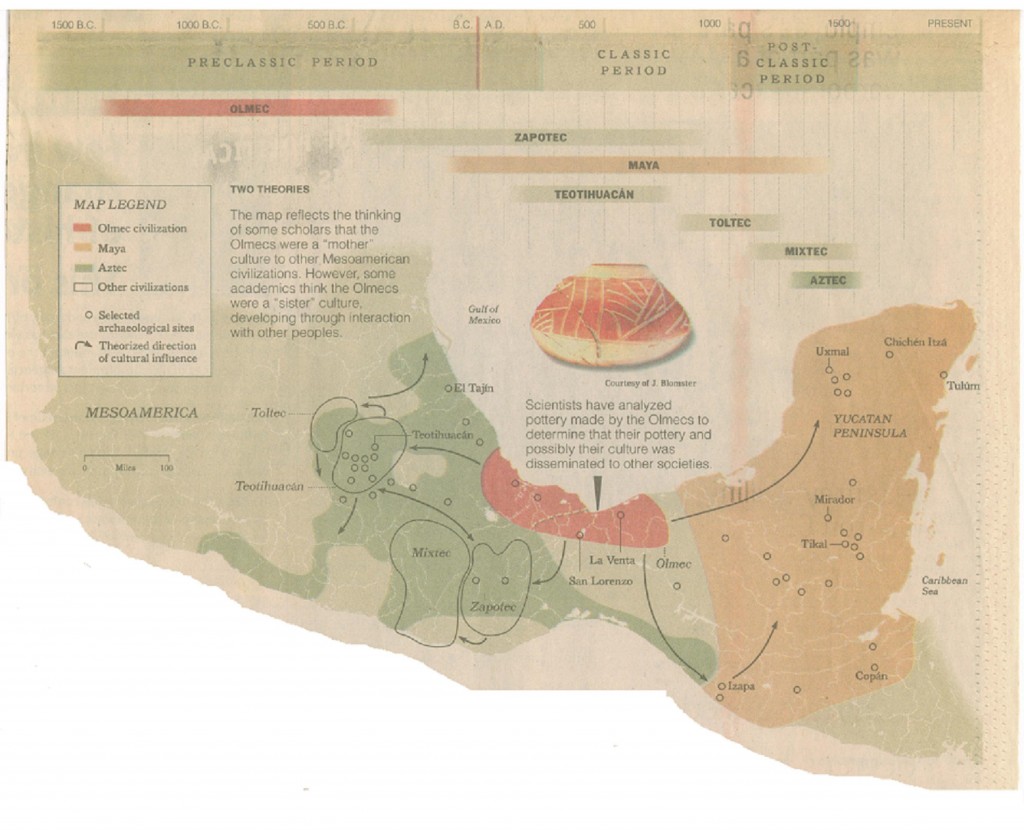
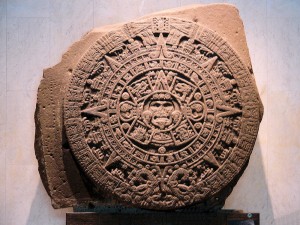



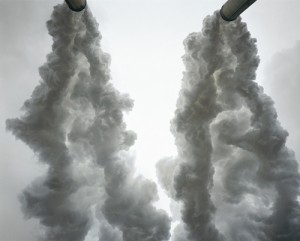
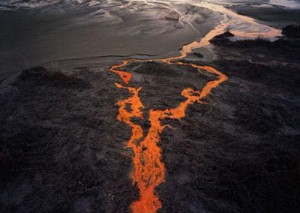



Elizabeth Marcus January 23, 2012 at 10:58 am
Christina Elson, former Mesoamerican curator at the Natural History Museum in NY and current principal at Sciencevisualization.com, wrote the following:
“I agree with you that we should take more care about where we are headed and that in many senses we are putting ourselves and our future in peril; however, I don’t agree with Jared Diamond’s assessment of Maya collapse and I think that generally most scholars do not think natural or cultural catastrophe is the best explanation for the changes that took place in the Maya lowlands in the 9th century. For good overviews on this scholarship you may wish to look at a recent publications called “Questioning Collapse” in which a number of researchers use case studies to examine ideas about why civilization change.
http://www.amazon.com/Questioning-Collapse-Resilience-Ecological-Vulnerability/dp/0521733669
In my own research, I have examined the end of the Classic in Central Mexico and Oaxaca. I will tell you that what happened in these places is not the disappearance of a culture or a lifeway, but rather a re-ordering of political organizations. I and others do think that Teotihuacan was quite a powerful city and exerted a strong influence on Mesoamerican politics. When Teotihuacan fell (yes, violently) it may have created something of a power vacuum. However, what is interesting is that in Central Mexico new cities spung up very quickly to fill this space, such as Tula, Cacaxtla, Cantona, Xochicalco. The main tenants of Mesoamerican society– social stratification, beliefs in the role of different social classes, the structure of the cosmos, time, etc. really did not change much at all. In Oaxaca, the situation is even more pronounced as the capital, Monte Alban, was abandoned over several centuries in favor of cities on the valley floor. At these cities (some new, some existing places that grew), elites and commoners continued to live much as they had done for millennia. It is true that economic productivity can vary greatly from year to year and that there probably was a severe drought in much of Mesoamerica around 900, but this is pretty much after cities like Monte Alban Tikal were in decline. In fact, centuries later, the Aztec survived another quite bad multi-year drought.
To me, decline has less to do with resource abuse and more with the fact that ancient political organization is inherently cyclical. Rulers have trouble securing long-term lineages, power struggles are common among elites (ruling families, urbanites and provincials, etc.), and sometimes common people may even find the opportunity to vote with their feet and leave un-productive power relationships. So, I would encourage you to keep reading and you will see that the Mesoamericas also have a number of stories to tell us about resilience.”
Elizabeth Marcus January 18, 2012 at 4:09 pm
From David Carballo, Boston University Professor of Archeology:
“Thanks for your note, interesting questions, and provocative blog post. I think that you hit the nail on the head regarding the past having something to tell us here in the present and applaud your efforts at contributing to the dialog in this regard. I should start by saying that I haven’t studied collapse intensively, though I am a Mesoamerican specialist.
Here are some publications I can point you to.
The first is called “Questioning Collapse” and is a recent rebuttal to some of the issues raised by Jared Diamond in his popular book “Collapse.”
http://www.amazon.com/Questioning-Collapse-Resilience-Ecological-Vulnerability/dp/0521733669
The second is an older book “The Collapse of Complex Societies”
http://www.amazon.com/Collapse-Complex-Societies-Studies-Archaeology/dp/052138673X/ref=sr_1_1?s=books&ie=UTF8&qid=1326156564&sr=1-1
The third is an edited volume
http://www.amazon.com/Collapse-Ancient-States-Civilizations/dp/0816512493/ref=sr_1_1?s=books&ie=UTF8&qid=1326156602&sr=1-1
And the final one is another blog written by a colleague about ancient cities, but dealing with many issues, including collapse (search in the index for those).
http://wideurbanworld.blogspot.com/2011/12/deep-history-vs-urban-revolution-which.html
To answer your particular questions about Mesoamerica, I have a few answers.
The first is, of course, that Mesoamericans haven’t gone away. There are something like 5 million Maya speakers and 3 million Nahuatl (Aztec) speakers. There are also countless decedents who speak Spanish and are much of the genetic pool of Mexico, Guatemala, and adjacent countries. Just yesterday I was driving through California’s San Joaquin Valley listening to a radio show where people would call in to speak to their relatives in Mixtec. In fact, Mixtec speakers are one of the major agricultural workers in California and the Southwest.
But it is striking that ancient Mesoamerican cultures underwent cycles of rise and collapse. I think there are a few reasons why their collapses look so stark. The first is that writing is limited for most cultural contexts, so, unlike in the Old World where we can link, say, the Mycenean Greeks to the Archaic ones, to the Classical ones, Hellenistic, Byzantine, etc., in Mesoamerica we have cycles of complex societies with uncertain resolutions and connections. In central Mexico, where I work, Teotihuacan gives way for several city states, including Xochicalco, Cacaxtla, and Cholula. These sites are very impressive and, though not as large as Teo at its height, are not an instance of cultural devolution. Rather, they bridge the gap between Teo’s collapse ca. AD 550-650, and Tula’s rise as the Toltec capital ca. AD 900. Tula, in turn, makes way for several competing Aztec city states before the Triple Alliance (Aztec Empire) unifies them into the largest polity of prehispanic Mesoamerica. So here there is a clear pattern of cycling city states which rise and balkanize repeatedly. An excellent example of central Mexican continuity comes from Cholula, which has occupation ca. 1000 BC, becomes the second largest city in central Mexico at the time of Teotihuacan, continues as an important Toltec and Aztec period center, then became a beautiful Colonial city, and is still occupied today—and worth a visit. Some people have speculated that Cholula continued while other large cities collapse because it was a pilgrimage and market center, rather than an imperial capital, like were Teotihuacan, Tula, and Tenochtitlan (the “big three” for central Mexico). In Mesoamerican history, Cholula is more famous for being conquered, than for conquering anything.
This brings me to my second point: Mesoamericans often terminated their cities and structures. This means that they saw buildings as living entities that needed to be consecrated, ritually “fed,” and then terminated of their power, often by burning central structures. Teo is a great example of this, where all the central structures were burned ca. AD 550/650, but 40 thousand people or so continued to live in the vicinity for centuries.
The final major point would be the major depopulation that was associated with European contact and conquest. Conservative estimates would put depopulation (mostly due to disease) at 50% in the decades after contact, but others go as high as 90%. In any event, this has done much to contribute to myths of simple savages and a pristine wilderness in our own country (it is remarkable if you compare early European accounts, like De Soto’s, of native population in the US South versus LaSalle, 100 years later).
Being 2012, the more spectacular case on people’s minds are the Classic Maya. Here’s a good recent book just on that:
http://www.amazon.com/Fall-Ancient-Maya-Solving-Collapse/dp/0500051135
No question the Classic Maya system based mostly in the Peten lowlands of Guatemala experienced failure and there was large scale depopulation, migration, and culture change. But right after this time the Maya underwent a new fluorescence in the Yucatan. After this collapse is when perhaps the most famous Maya site (Chichen Itza) was constructed. After that there was Mayapan and Tulum–the latter oft visited by people from Cancun. As an architect, you may appreciate that some of the most elaborate architecture (the Puuc style) comes from after the Classic collapse. So, although writing and other elements of court culture do change, it is not a wholesale devolution of culture, rather a reconfiguration. Things, in general, become less focused on monarchies and more collective—maybe people were tired of all these showy kings of the Classic.
There is an excellent chapter in this book
http://www.amazon.com/Comparative-Archaeology-Complex-Societies/dp/0521142121/ref=sr_1_1?s=books&ie=UTF8&qid=1326157985&sr=1-1
by Roland Fletcher, who compares the Maya collapse to SE Asia, his area of expertise. His argument is that these two tropical lowland civilizations underwent spectacular collapses (Angkor was the largest city of the preindustrial world) because their ecosystems were so heavily managed for water works, that with a few stresses (climate change, war, etc.) the whole thing fell apart. So SE Asia would be another place to look at collapse, perhaps.
I see making the past relevant to the public in the present as an important ethical responsibility of ours and am happy to see blogs like yours. Hope that these suggestions help in your researching these topics!”
Elizabeth Marcus January 18, 2012 at 4:02 pm
In search of expert opinions on whether there was, in fact, a pattern of collapse in ancient Mexico, I wrote to several Mesoamerican scholars. Here are some of the responses:
From Joseph Tainter, writer of the seminal work, “The Collapse of Complex Societies.
“Thank you for your email and very interesting essay. I would only recommend that it is important to define what you mean by collapse.
With best wishes,
Joseph Tainter”